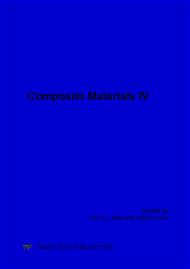p.121
p.129
p.139
p.145
p.151
p.159
p.165
p.171
p.177
Mechanical Behavior of a Hybrid Reinforced Magnesium Composite Fabricated by Pressure Infiltration Method
Abstract:
A hybrid reinforced composite based on magnesium alloy AZ60A reinforced with B4C particulates and SiC wisker, with volume percentage of 12% of each reinforcement respectively, was fabricated using pressured infiltration processing technique followed by hot extrusion. The microstructure of the composite and the fracture surface of tensile sample were investigated by optical microscopy and scanning electron microscopy (SEM). The results show a nearly uniform distribution of the reinforcements throughout the as-extruded magnesium matrix, and the SiC wiskers were observed with its longitudinal distributing along with the extrusion direction. Tensile experiment after extrusion revealed that the hybrid reinforcements significantly increase the elastic modulus and ultimate tensile strength of the composite material. The elastic modulus and the ultimate tensile were reached to 80.2GPa and 420 MPa, which were 100% and 34% higher than that of the matrix material. Moreover, numerical models (FEM) by an axisymmetric unit cell method were used to investigate the evolution of voids volume fraction in metal matrix during tensile process. The results show that the cracking is prone to form and grow near wisker than particulates.
Info:
Periodical:
Pages:
151-158
Citation:
Online since:
July 2006
Authors:
Price:
Сopyright:
© 2006 Trans Tech Publications Ltd. All Rights Reserved
Share:
Citation:


